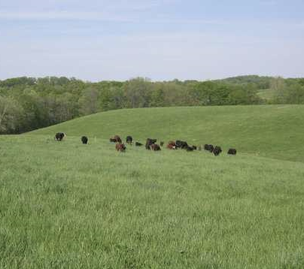
As stored feed needs go down, the profitability of a livestock operation generally goes up. Growing several pasture forage crops with differing growing seasons is an excellent way to provide more total days of grazing on a given farm. Annual forages often play an extremely important role in extending grazing, but most forage programs are based around perennials, so a discussion of perennial pasture forage crop options should be highly appropriate.
In the Upper South (including Tennessee, Kentucky, North Carolina, and the more northern parts of Alabama, Georgia, and South Carolina) tall fescue is the most widely grown pasture forage. Tall fescue and orchardgrass are cool season perennials that have long growing seasons. White clover (also a perennial) and especially red clover (a biennial) can help extend the grazing season even farther. During a hot, dry summer, the amount of forage provided by the cool season forages that dominate in this area could benefit greatly from having more warm season pasture acreage.
In recent years, interest has increased in growing bermudagrass (a warm season perennial) farther north than it has traditionally been grown. A few vegetatively-propagated varieties can persist in the Upper South, but planting material is not widely available. There are also some seed-propagated varieties or blends that are winter-hardy enough to survive in parts of the Upper South. Forage yield is less than from vegetatively propagated varieties, but they are easier and less expensive to establish. The winterhardiness of varieties currently available (whether vegetatively- or seed-propagated) varies greatly.
Dallisgrass is a warm season perennial grass that is widely distributed throughout much of the Upper South and portions of the Deep South. It greens up in early Spring, and thus can provide some pasture forage before other warm season perennial species. However, except in certain low-lying sites and/or heavy soils, dallisgrass is usually not a dominant pasture forage species. Johnsongrass, another warm season perennial, is adapted in many of the same areas as dallisgrass, but is usually grown for hay rather than pasture forage.
The warm season perennial native grasses switchgrass, Indiangrass, eastern gamagrass, big bluestem, and little bluestem have also become more popular in recent years. These are widely adapted, drought tolerant, and potentially quite productive, and can provide surprisingly good forage quality. Native grasses are especially useful in the Upper South because their growth pattern complements that of cool season forages. However, as compared to most other forages, they require more establishment precision, and a higher level of grazing management.
Sericea lespedeza is a warm season perennial legume that can be used to advantage, especially in the Upper South. Sericea has several attributes as a forage crop, but two are especially unique and valuable. First, it can be grown on poor land where other forage crops are not well suited, and secondly, it can provide very low-cost production. Interest in sericea has increased recently, mainly because research has shown that it serves as a natural de-wormer for small ruminants.
In the Deep South (which includes southern parts of South Carolina, Georgia, Alabama, and Mississippi as well as the states of Louisiana and Florida, bermudagrass and bahiagrass (also a warm season perennial) dominate pasture acreage in most areas. Bahiagrass has a longer growing season than bermudagrass, although some varieties of each species have longer growing seasons than others. In this area most sites and soils are not suited for growing cool season perennials, but cool season annuals such as ryegrass are widely drilled into or overseeded on dormant summer grass sods.
There is a significant acreage of alfalfa (a cool season perennial) in the South (particularly the Upper South) but it is mostly grown for hay. Lastly, a warm season perennial legume that can be grown in Florida and the southernmost parts of nearby states is perennial peanut. It must be vegetatively propagated and, like alfalfa, is mainly grown for hay.
A couple of other forages could be added to this list, but the overwhelming majority of perennial forages grown for pasture in the area from Kentucky to north Florida and from east Texas to the Atlantic coast are dominated by the species mentioned. Data generated by university variety trials and other experiments provides yields, growing seasons, forage quality, and other information about these forages and also varieties within the species.
__________________
Foraging Ahead is a column presented by Ragan & Massey and written by Dr. Don Ball, Professor Emeritus at Auburn University. Dr. Ball is one of the authors of the popular book “Southern Forages,” which can be found via a computer search that uses the words, “Southern Forages, The Fertilizer Institute.”
